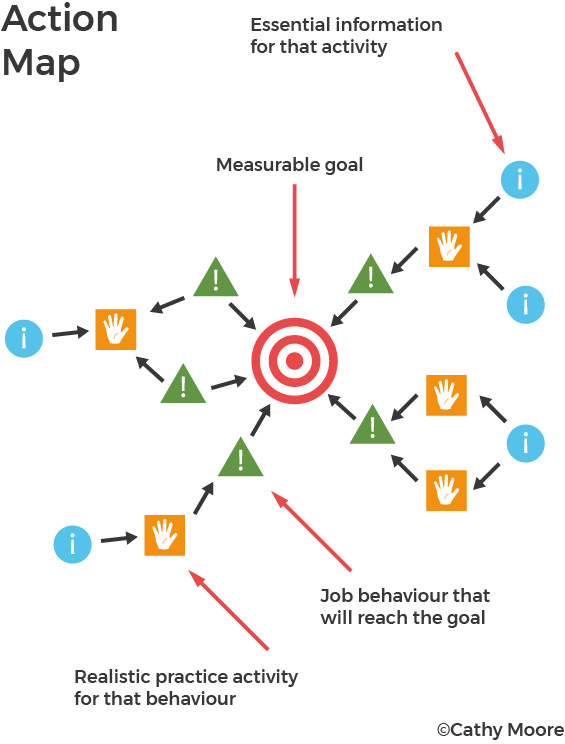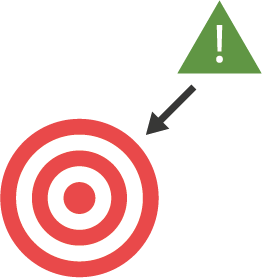Dynamic. Henry Fuller.

26 July 2021
Action mapping in instructional design. How it can help.
There’s no doubting that action mapping in instructional design is a hot topic. It’s a phrase often heard in learning circles. But what is action mapping and how can it help your goals? Planning a digital learning solution at a high level is an essential part of the instructional design process. For most projects, here at Dynamic, we now invite clients to get involved in an online action mapping exercise as a prerequisite to storyboarding or scripting.
People have their own analysis and planning method preferences action mapping is a great technique to achieving the most impact with your learning intervention.
Action mapping questions
Action mapping is largely based around the following key questions:
1.
What is the goal and how will it be solved?
2.
How will people reach the goal?
3.
Why aren’t people doing what they need to?
4.
What changes will help?
Historically, I have looked to project SMEs to provide answers to these questions but have recently been wondering – is that right?


Instructional design problem
Let’s start with the first question, ‘What is the goal?’
In our experience, the goal is usually set by someone in a senior leadership position who then passes it on to a project sponsor to action.


Now for the second, third and fourth questions
The best people to answer these questions are those at the centre of the problem, such as the colleagues, line managers or heads of department. Not necessarily SMEs or project sponsors.
Generally, SMEs are typically appointed to projects because they are considered to hold all the knowledge around a given subject. Not because they understand the specifics of why a problem exists or because they know the best way to solve it.
For example, a project to create a new Cyber Security learning solution will often have a Cyber Security expert as the main contact. But usually the people whose behaviour needs to change are the colleagues and data handlers, not the experts.
Despite this, people at the centre of the problem are very rarely part of the project team and therefore are not party to any action mapping activities. So, we are then relying on members of the project team to relate the requirements second-hand. And this is usually ahead of project kick-off, so that we can attempt to acquire the information by proxy.
However, this doesn’t always pan out as planned so I have introduced a new step into the project process.

Action mapping solution
Firstly, we aim to seek buy-in from the client that they are happy for a number of end users to be contacted. We then prepare a simple online survey asking them to self-assess their competence in each of the job behaviours that have been defined by the action mapping process.
For example, let’s imagine, that we’re creating some training on Operational Expenditure. By working through action mapping in the instructional design process, we have established that the goal of the training is:

To increase financial acumen for Operational Leaders across the company to drive a 10% reduction in operational expenditure by the end of the year.
Then we decided that one job behaviour that will reach this goal is:
To create of a profit and loss statement.
Now, there are a number of different skills involved in this whole task and to assume that learners are equally competent in each of them may be a mistake. And that’s how a simple end user survey can help.

Survey example
Constituent skill 1: Calculating revenue
I am fully competent in using a profit and loss statement to calculate revenue.
Constituent skill 2: Calculating cost of goods sold
Subtracting the cost of goods sold using a profit and loss statement is within my skillset.
Constituent skill 3: Adding additional income
I can add additional income to a profit and loss statement.

By the time it’s completed by a cohort of end users, survey’s results are ready and you can analyse and the performance identify gaps. You could call it a kind of training needs analysis.
Undeniably, we’ve seen some fantastic results at Dynamic from this approach, with a wide range of different clients.
As a matter of fact, one client we’ve worked with recently decided to ask the questions in a focus group ahead of the project start date. The information that came out of it is instructional design gold. Without it, the project would simply have missed the mark.
The specific method of gathering this information varies from company to company. And of course, it depends on the audience. But the Dynamic team can support this information gathering process, however it is conducted.

Applying action mapping in instructional design
Finally, do you have a learning intervention planned? Or a learning need you’re still trying to get to grips with? Then think about the four questions of action mapping and who would be the best people to speak to for each of them.
Get in touch with the Dynamic team today for a demo of how we can optimise the capture your learning requirements. All things considered, his will ultimately help in achieving a better learning outcome for you and your team.








